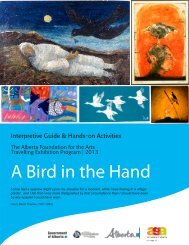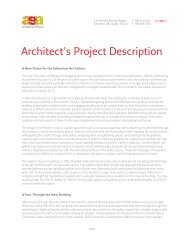Urban Animals - Art Gallery of Alberta
Urban Animals - Art Gallery of Alberta
Urban Animals - Art Gallery of Alberta
Create successful ePaper yourself
Turn your PDF publications into a flip-book with our unique Google optimized e-Paper software.
The <strong>Alberta</strong> Foundation for the <strong>Art</strong>s Travelling Exhibition Program<br />
Charcoal Cave Drawings K-6<br />
Background<br />
Begin by examining animal drawings found in a variety <strong>of</strong> prehistoric caves throughout<br />
the world. Discuss with students that, in drawing the animals prehistoric peoples hunted,<br />
the artists used simplified shapes and expressive lines to create their images. Such<br />
techniques are similar to the basis used for the images by Jason Carter found in the<br />
exhibition <strong>Urban</strong> <strong>Animals</strong>.<br />
Cave artists applied paint to the walls in a variety <strong>of</strong> ways. They were as creative in developing<br />
their techniques as they were in their illustrations. They used their bodies and whatever else<br />
was available in simple ways such as finger-painting, brushing, smearing and dabbing, and in a<br />
more sophisticated manner by stencilling or spraying. When large areas <strong>of</strong> colour were needed<br />
they speeded up the work with pads <strong>of</strong> lichen or moss.<br />
Blending Techniques used by cave artists:<br />
Brush the colours carefully with a feather<br />
Paint with paint brushes made from horse hair<br />
Spray paint through the hollow bone <strong>of</strong> a bird<br />
But cave artists weren’t satisfied with ‘just colour’. Cave artists blended colours together directly<br />
on the wall, in various ways, to create more accurate or more interesting colours.<br />
The Drawings<br />
Cave artists weren’t satisfied with ‘just lines’, either. They produced a variety <strong>of</strong> expressive lines<br />
by drawing with twigs, and if a line was particularly significant they planned it in advance,<br />
marking it out with dots which they joined up later. They also used the natural hollows <strong>of</strong> the<br />
stone surface to give a more 3D effect, planning their paintings in advance to take advantage <strong>of</strong><br />
the shadows produced by the angle <strong>of</strong> the incoming light.<br />
Cave artists carried out their amazing art work in the darkness <strong>of</strong> the cave, illuminated only by<br />
oil lamps, or sometimes by a shaft <strong>of</strong> light which might penetrate a cave close to the outside at a<br />
certain time <strong>of</strong> day. Some <strong>of</strong> their paintings were on a huge scale. Ceiling paintings - which were<br />
sometimes vast - required teamwork, and scaffolding structures to enable the artists to reach<br />
the painting surface.<br />
Student example <strong>of</strong> Lascaux Cave drawings<br />
AFA Travelling Exhibition Program, Edmonton, AB. Ph: 780.428.3830 Fax: 780.421.0479<br />
youraga.ca

















